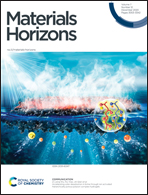Unusual electrical conductivity driven by localized stoichiometry modification at vertical epitaxial interfaces†‡
Abstract
Precise control of lattice mismatch accommodation and interfacial cation diffusion is critical to modulate correlated functionalities in epitaxial heterostructures, particularly when the interface composition is positioned near a compositional phase transition boundary. Here we select La1−xSrxMnO3 (LSMO) as a prototype phase transition oxide and establish vertical epitaxial interfaces with NiO for exploring the strong interplay between strain accommodation, stoichiometry modification, and localized electron transport across the interface. It is found that localized stoichiometry modification overcomes the dead layer problem plaguing LSMO and leads to strongly directional conductivity, as manifested by a more than three orders of magnitude difference between out-of-plane and in-plane conductivity. Comprehensive atomic scale structural characterization and transport measurements reveal that this emerging behavior is created by a compositional change produced by preferential cation diffusion that pushes the LSMO phase transition from insulating into metallic within an ultrathin interface region. This study explores the nature of unusual electrical conductivity at vertical epitaxial interfaces and highlights the beneficial role of controllable cation diffusion that enables emerging functionalities for a broad range of potential applications such as memristors, spintronic devices, and novel nanoelectronic devices using strongly correlated materials.



 Please wait while we load your content...
Please wait while we load your content...